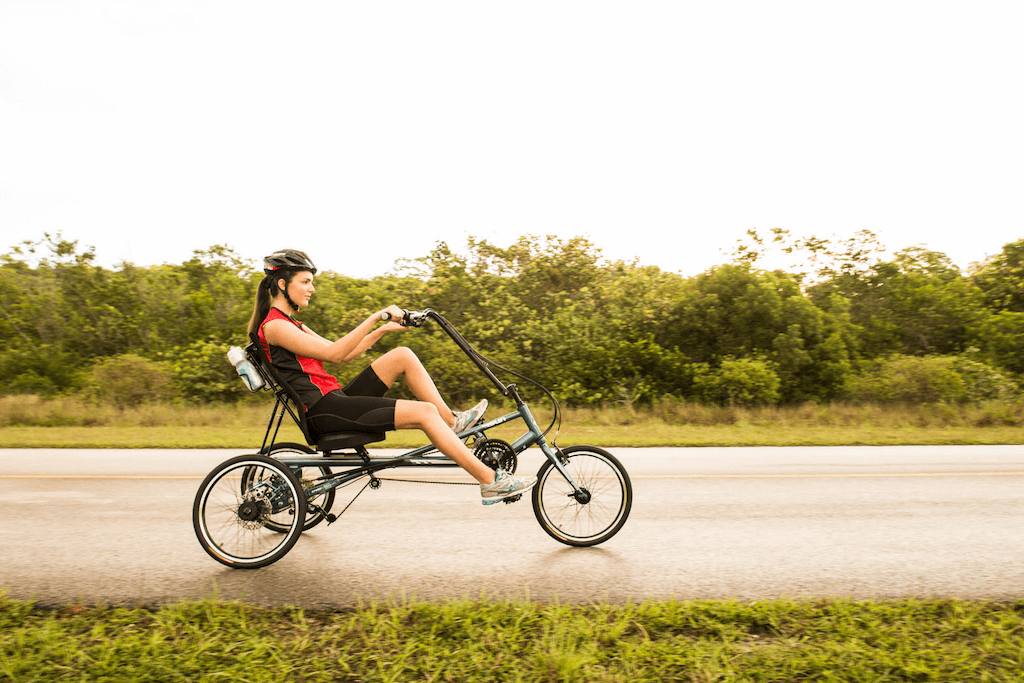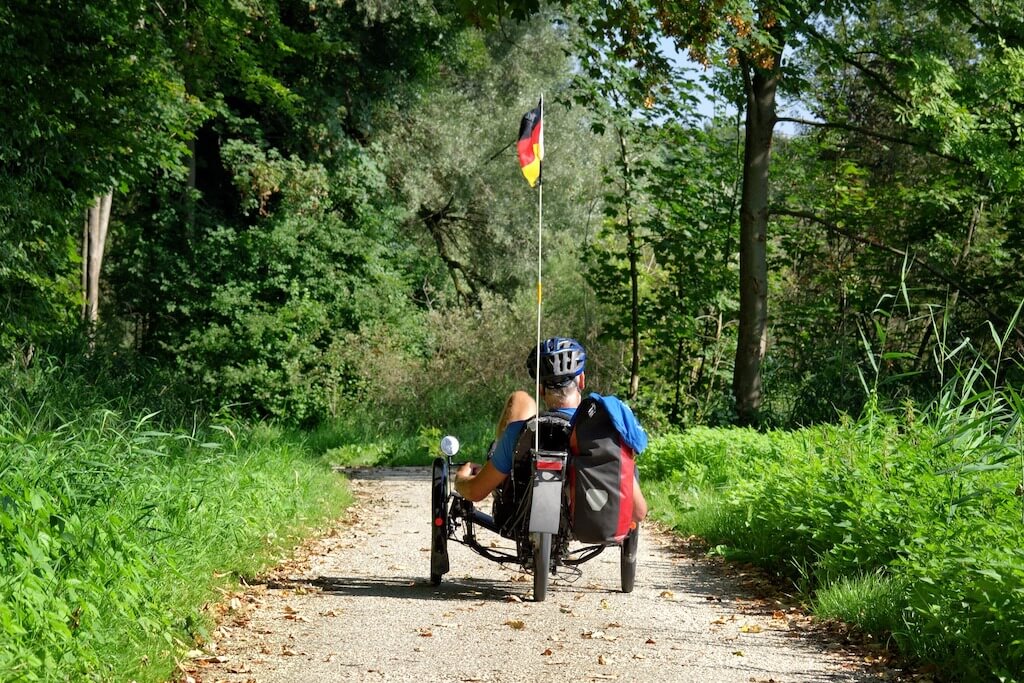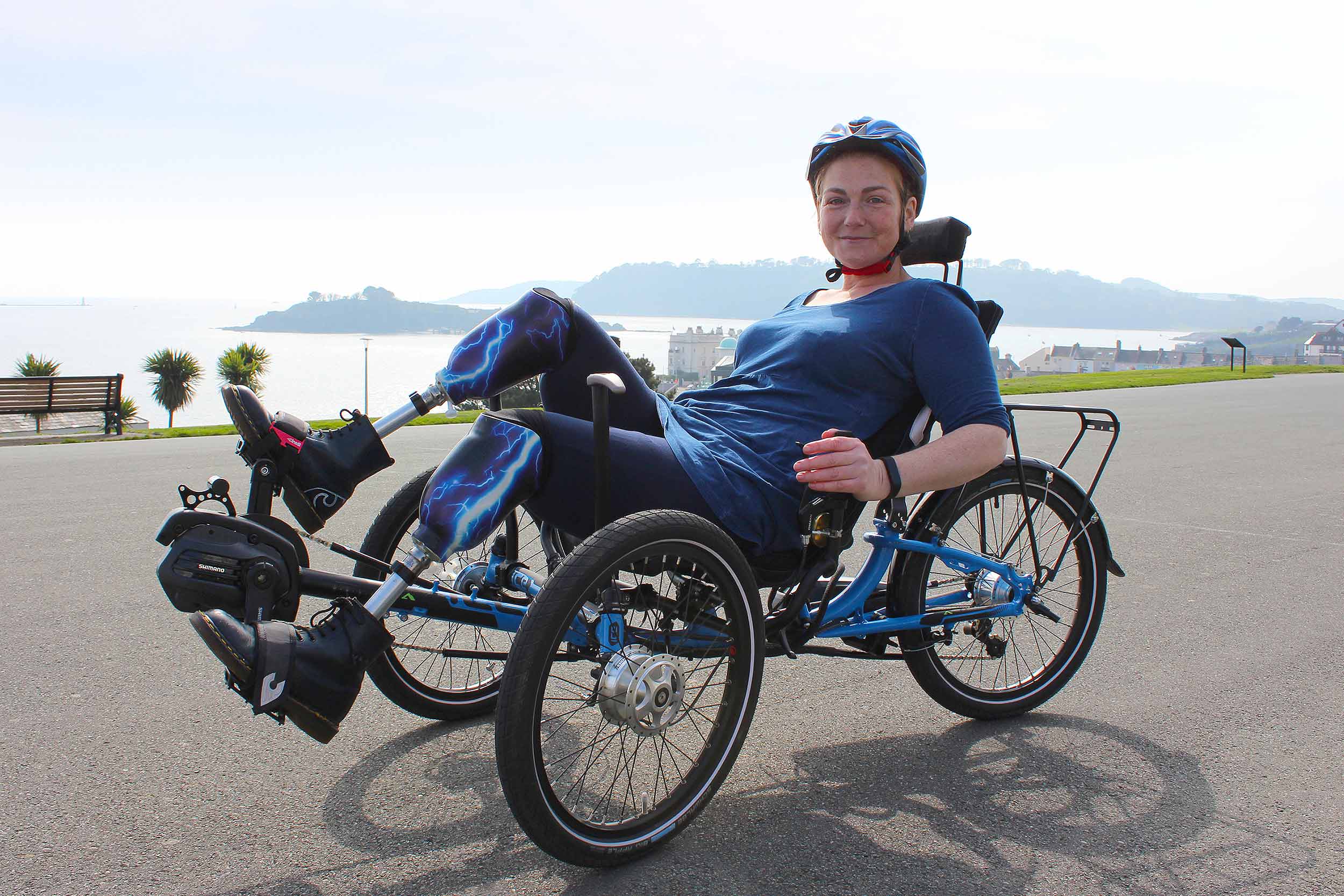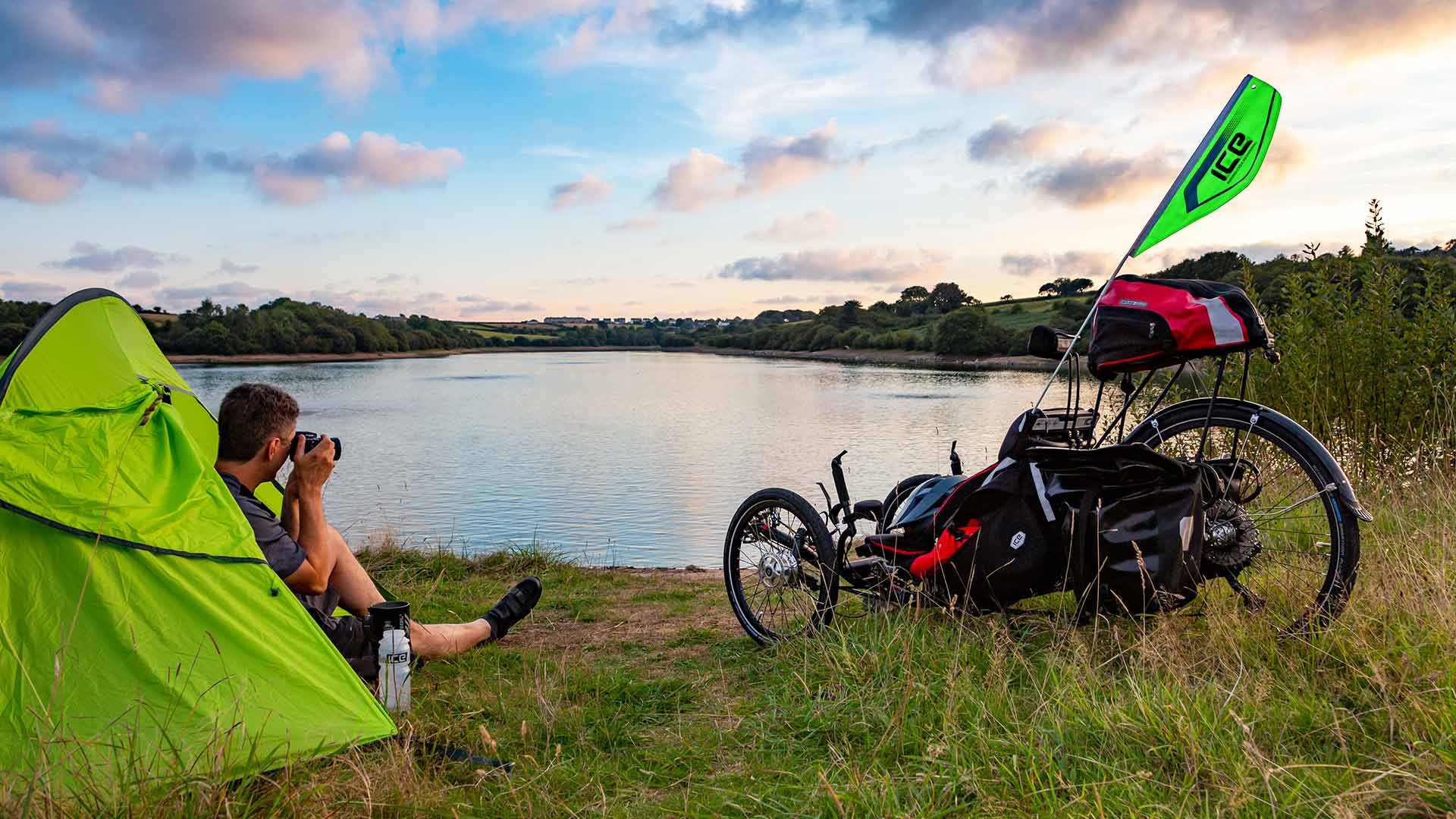Autumn Gear Guide
Find inspiration in our Gear Guide that will keep you out on your bike through wind or rain.
Download NowWhether you’re cruising down the bike path, commuting to work, or racing in a triathlon, a recumbent bike will help you ride longer, faster, and with a smile on your face. Aren’t you tired of hunching over your handlebars, feeling every bump in the road, and arriving at your destination with a sore neck and […]
Whether you’re cruising down the bike path, commuting to work, or racing in a triathlon, a recumbent bike will help you ride longer, faster, and with a smile on your face.
Aren’t you tired of hunching over your handlebars, feeling every bump in the road, and arriving at your destination with a sore neck and aching wrists? It’s time to switch to a recumbent bicycle and experience the joy of cycling in comfort and style! Recumbent bicycles offer a unique and comfortable riding position that is sure to turn heads and make you the envy of your cycling buddies. Whether you’re cruising down the bike path, commuting to work, or racing in a triathlon, a recumbent bike will help you ride longer, faster, and with a smile on your face. So sit back, relax, and let’s dive into the world of recumbent bicycles.

Recumbent from Sun Seeker Bicycles (pictured above also Sun Seeker)
Let’s take a look at recumbent bicycles.
A recumbent bicycle is a type of bicycle that features a reclined seating position, where the rider’s back is supported, and their legs are extended forward to reach the pedals. Unlike traditional upright bicycles, which have a more vertical seating position, recumbent bicycles have a lower center of gravity, which can make them more stable and comfortable to ride for longer periods.
Recumbent bicycles come in a variety of styles, including two-wheelers, three-wheelers, and even four-wheelers, and they can be designed for use on roads, trails, or even for racing. They are often preferred by people who have back, neck, or shoulder pain, as the reclined position can alleviate pressure on those areas. Additionally, recumbent bicycles can be easier on the wrists and hands, making them a good choice for riders with carpal tunnel syndrome or other wrist or hand issues.
“Once you’ve ridden a recumbent, it’s hard to go back to a conventional bike. You’re more comfortable, you can see more, and you just have more fun,” said David Bernstein, co-founder of the Recumbent Cycle-Con Trade Show, in a Wall Street Journal article.
The origins of the recumbent bicycle date back to the early 19th century, with various designs and prototypes appearing throughout the years. However, the first practical recumbent bicycle was invented by Frenchman Charles Mochet in 1923.
Mochet was an engineer and designer who had a passion for cycling. He wanted to create a bicycle that was more comfortable and aerodynamic than the traditional upright design. His first recumbent bicycle, called the “Velocar,” had a low-slung frame and a reclined seat, with the pedals positioned in front of the rider’s body.
In 1933, Mochet’s Velocar gained worldwide attention when it was used by French cyclist Francis Faure to break the world speed record for a human-powered vehicle. Faure rode the Velocar at an average speed of 54.7 miles per hour, a record that stood for more than 30 years.
During the 1970s, interest in recumbent bicycles experienced a resurgence as more people began to recognize the potential benefits of this innovative design. In 1978, the International Human Powered Vehicle Association was formed, which led to the development of new technologies and materials that further improved the performance and comfort of recumbent bicycles.
Since then, recumbent bicycles have continued to evolve and improve, with many innovative designs and materials being used to create bikes that are faster, more comfortable, and more efficient than ever before. Today, recumbent bicycles are used by cyclists of all ages and abilities, with many models available for various types of riding, including touring, racing, and commuting.

Recumbents come in different shapes and sizes to tackle a variety of terrain
There are many different types of recumbent bicycles available, each with its own set of pros and cons. Some models are designed for touring and long-distance riding, while others are built for speed and racing. Recumbent bicycles can also be powered by human pedaling or by electric motors, making them a versatile option for riders of all abilities.
Long wheelbase recumbent bicycles are the most common type of recumbent bicycles and feature a design where the front wheel is located behind the pedals. This creates a longer wheelbase, which provides improved stability and a smoother ride. Long-wheelbase recumbent bicycles are a popular choice for touring and long-distance riding, as they offer a comfortable and efficient way to cover long distances.
Short-wheelbase recumbent bicycles feature a design where the front wheel is located in front of the pedals, which creates a shorter wheelbase and a more compact design. This makes them more maneuverable and responsive, which makes them a great choice for racing or off-road riding. Short-wheelbase recumbent bicycles are also a popular choice for commuters, as their compact design makes them easier to store and transport.
Recumbent trikes, also known as recumbent tricycles, feature three wheels instead of two, which provides improved stability and balance. This makes them a great option for those who may have difficulty balancing on a traditional bicycle or recumbent bicycle. Recumbent trikes are available in both long and short-wheelbase designs and are a popular choice for touring, commuting, and even off-road riding.
Tandem recumbent bicycles are designed for two riders and feature a recumbent seating position for both riders. This creates a comfortable and efficient way for two people to ride together, with one rider providing the power while the other rider provides support. Tandem recumbent bicycles are a popular choice for touring and long-distance riding, as they offer a fun and social way to explore the world on two wheels.
Handcycles are a type of recumbent bicycle designed for riders who may have limited or no use of their legs. Instead of pedals, handcycles feature hand cranks that allow riders to propel themselves forward. Handcycles are available in a variety of designs, including long and short-wheelbase models and trikes, and are a great way for people with mobility issues to enjoy the benefits of cycling.
An electric recumbent bicycle is powered by an electric motor, which provides assistance to the rider when pedaling. This type of recumbent is ideal for people who want to travel long distances or have difficulty pedaling due to physical limitations.
A velomobile is a fully enclosed recumbent bicycle designed for commuting or touring. It provides protection from the weather and offers excellent aerodynamics, making it faster and more efficient than traditional bicycles.

Recumbents can also offer some serious speed and fun with models such as this one seen in Toronto
Recumbent bicycles can have several types of steering mechanisms, each with its own set of advantages and disadvantages.
For elderly riders, recumbent bicycles provide a comfortable and low-impact way to stay active and maintain cardiovascular health. The reclined position helps to reduce stress on the back, neck, and joints, making it a great option for those with arthritis or other conditions that make traditional cycling uncomfortable.
Similarly, for those with mobility issues or disabilities, recumbent bicycles can be a life-changing alternative to traditional bicycles. They offer improved stability and safety, allowing riders to enjoy the freedom and independence of cycling without the risk of falls or other accidents.

Recumbents are a great option for those with mobility challenges, here from ICE Bikes
“Recumbent bikes have been a godsend for me. They are the only way I can get outside and enjoy cycling again. It has given me freedom and independence that I had lost, and my fitness and health have improved immeasurably as a result,” said David Wilson, a recumbent cyclist with multiple sclerosis, to The Guardian.
This style of bicycle has evolved and has also become a good option for seniors.
“Recumbent bikes are great for older adults who may have trouble balancing or have other physical limitations,” said Rachel Gribble, a fitness specialist at the National Institute on Aging. “They offer a comfortable and stable riding position that makes it easier to enjoy cycling without putting excessive strain on the back, neck, or wrists.”
This style of bicycle also continues to have a cult-like status amongst a small but committed group of enthusiasts who invest significant time and money into high-end recumbent bicycles.
Recumbent bicycles are generally considered to be as safe as traditional bicycles, but there are a few factors that may affect their safety.
One potential concern is visibility. Recumbent bicycles sit lower to the ground than traditional bicycles, which can make them harder to see for other road users, particularly motorists. To mitigate this risk, many models are designed with brightly colored frames or reflective materials, and riders may also wear high-visibility clothing or use lights.
Another concern is stability. Recumbent bicycles typically have a lower center of gravity than traditional bicycles, which can make them more stable at high speeds. However, this design can also make them more difficult to handle at low speeds or when navigating tight turns. Riders should practice safe riding techniques, such as using appropriate braking and steering techniques, to ensure that they maintain control of their bicycle.
“Recumbent bicycles are just as safe, if not safer, than traditional bicycles. In fact, the lower center of gravity and reclined riding position may actually make recumbent bicycles less likely to tip over or cause a loss of control in sudden turns or stops,” said Bob Bryant, founder of the Recumbent Cycle-Con Trade Show & Convention.
Finally, some people worry that the reclined position may make it more difficult for the rider to see the road ahead or to react to sudden obstacles. However, most riders can adapt to the position and find that it does not significantly affect their ability to ride safely. In addition, recumbent riders have their heads up instead of tilted or down on traditional road bikes, so there is a better chance of seeing obstacles and other dangers in plenty of time to avoid them.

Recumbents are a great option for many who want to embrace cycling but have balance issues or just want something different (photo: ICE)
While there are many advantages to riding a recumbent bicycle, there are also some potential drawbacks to consider. For example, this style of bicycle can be more challenging to maneuver in tight spaces or on rough terrain. They can also be more expensive than traditional bicycles, and some models may require special training or adjustments to get used to the different riding positions. In addition, some recumbents lower to the ground are not as visibile as traditional upright bicycles and are less safe on city roads.
If you’re considering purchasing a recumbent bicycle, there are several factors to consider. These include your riding goals and preferences, your budget, and your physical abilities. It’s also important to test-ride several different models to find one that feels comfortable and suits your needs.
For those who love the feeling of being low to the ground and having a reclined position, recumbent bicycles provide an entirely different riding experience. They offer a level of comfort and support that cannot be matched by traditional bicycles, with the rider’s weight distributed across a larger surface area, reducing pressure points and minimizing strain on the back and neck.
But beyond comfort, recumbent bicycles are also known for their aerodynamic design, which can lead to faster speeds and improved efficiency. This is especially true for racing recumbent bicycles, which are designed for maximum speed and are a popular choice among time trialists and ultra-endurance riders.
Recumbent bicycles are a unique and comfortable option for cyclists of all ages and abilities. With their ergonomic design, lower center of gravity, and reclined riding position, recumbent bicycles offer a safe, stable, and enjoyable way to ride. Whether you’re looking for a trike for touring, a fast and agile two-wheeler for racing, or a comfortable and convenient bike for commuting, there is a recumbent bicycle that can meet your needs. When choosing a recumbent bike, be sure to consider factors such as the style, size, material, and features that best suit your goals and preferences. With the right recumbent bike, you can experience the joy and freedom of cycling in a whole new way.
Find inspiration in our Gear Guide that will keep you out on your bike through wind or rain.
Download Now
I am priced out of a lot of the recumbent bicycles I’ve looked at. I am interested in finding a solid, but more affordable used recumbent bike. How do I find one?
The descriptions of long and short wheelbase models have been partially reversed, in this article. Long wheelbase have pedals behind the front wheel, while short wheelbase have pedals ahead of the front wheel.
I agree with Joe. Motorists generally give me more room, when I ride a recumbent bicycle.
The concern about not being seen by drivers is complete misperception: drivers tend to pay MORE attention to recumbents, probably due the different-ness. For anyone still worried, tall flags and spinners are eye-catching.
That said, the real concern is the fact that most ‘bents are seated at the same height as a small car, or lower, making seeing *through* taller cars at intersections an issue. For this reason, I’d recommend folks in places that don’t have dedicated, protected bike infrastructure look at ‘bents with taller seated positions.
Also, trikes are more affected by street camber than bikes (‘bent or upright), so that is something else to keep in mind when looking at trikes.
Comments are closed.